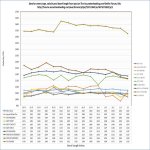As you have indicated the top row is testing of match ammo. In every instance, the muzzle velocity is greater at 18.75" than at 24.75".
Of the 10 ammos test, fully 8 of the ammos have a greater muzzle velocity at 18.75" than at 24.75".
In general, longer barrels using 22LR ammo, result in lower muzzle velocities.
Walter, for goodness sake, take a break. You continue to take issue with the idea that there isn't a consistent relationship between barrel length and MV. It's not clear why. Unfortunately, the basis for your disagreement has become weaker with each of your posts.
Your observation about MVs in the top row only all being faster at 18.75" than at 24.75" is indeed correct. What's more significant, however, is that it's obvious this relationship doesn't hold consistently at the other barrel lengths. In other words, there isn't a consistent relationship between barrel length an MV.
Perhaps if you have new information that will enhance readers understanding of the relationship between .22LR MV and barrel length, you will direct readers to it. In its absence, this discussion should discontinue.








































































